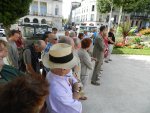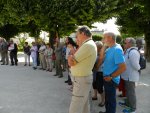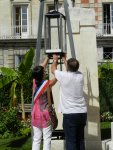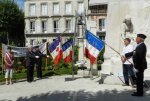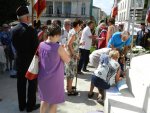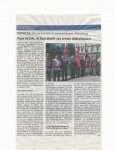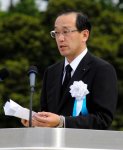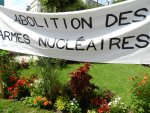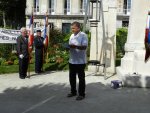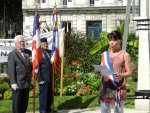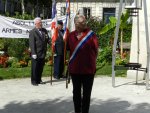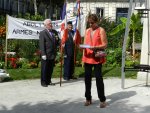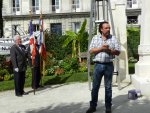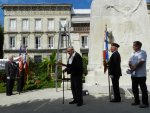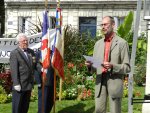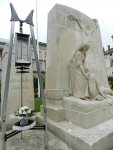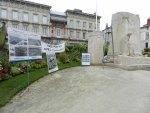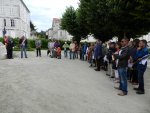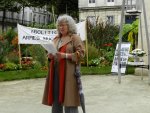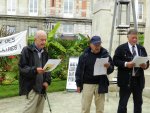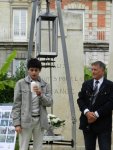SAINTES, CEREMONY ON 6 AUGUST 2015
Marking the 70th anniversary of the bombing of Hiroshima
Report
There were about fifty people at this moving ceremony.
Among the group, four French départements were represented : the Charente-Maritime (Saintes of course, but also Saint-Pierre and Saint-Georges d’Oléron, Saint Jean d’Angély, Pons, Mirambeau, Gémozac, Matha...), the Charente (Cognac), the Deux-Sèvres (Niort, Parthenay, la Gâtine), and the Gironde (Bordeaux).
Jean-Michel Audoire (ACDN) introduced the ceremony by thanking those present :
« We are certainly fewer than the crowd at Hiroshima’s own commemoration, ten hours ago, remembering the bombing of 70 years ago. But Hiroshima today has 1.2 million inhabitants, and Saintes about 40 times less. Besides, Saintes has been lucky, despite the price she has paid in 2000 years of history, in numerous wars including the Second World War... lucky not to have known the massacre of Oradour-sur-Glane (1944) or those of Hiroshima and Nagasaki. One must therefore make some effort to imagine the horror of it, and to realise that 70 years later we too are still threatened, every day. You have made such an effort in coming here. We thank you ».
Jean-Marie Matagne, president of ACDN, recalled the circumstances and the motives of the Hiroshima bombing, in the same terms, subsequently confirmed, as his study published in August 2000 under the title of Hiroshima, Nagasaki: a poorly-known story and some lessons of burning relevance.
The next speaker was Mme Marie-Line Cheminade, vice-mayor of Saintes, representing the city. She told us what her presence signified. So did the next speakers Mme Catherine Quéré, MP for Saintes and Saint-Jean d’Angély, Mme Brigitte Favreau, councillor of the Charente-Maritime département, M. Benoît Biteau, councillor and vice-president of the Poitou-Charentes Region, and M. Georges Mounier representing the local branch of War Veterans.
See all speeches below.
Then Mr Patrick Moquay, former mayor of Saint-Pierre d’Oléron, explained why he had wished his town, like Saintes, to join the Abolition 2000 network and Mayors for Peace. Next he read the message which M. Kazumi Matsui, Mayor of Hiroshima and international president of Mayors for Peace, had written to ACDN for this ceremony. Everyone heard his strong call to work for the abolition of nuclear weapons and for a world at peace.
See this message just below.
Mme Cheminade joined with M. Matagne to re-light the Nuclear Disarmament Flame, and then with Aude Labat (ACDN) to place a wreath of white flowers, like those which the Japanese lay or throw into the river Otha to evoke the souls of their dead.
The audience observed a minute’s silence in memory of the victims of Hiroshima, while War Veterans lowered their flags.
All the participants then came to place their individual candle-flames at the Monument to the Fallen, not far from the main Flame.
An invitation was issued for those who can to come to the same place on 9 August at 10.45, to pay tribute to the victims of Nagasaki and to extinguish the Nuclear Disarmament Flame until the next time. It shall be lit again next October during the Gathering for a Livable Nuclear-free World.
Article on line by Fabien Paillot in Sud Ouest
Article by Aline Ledoux in Haute Saintonge
Message from the Mayor of Hiroshima
It is an honor and pleasure to send this message on the occasion of Hiroshima-Nagasaki Ceremony.
On August 6, 1945, a single atomic bomb rendered Hiroshima a burnt plain. From infants to the elderly, tens of thousands of innocent civilians lost their lives in a single day. By the end of the year, 140,000 had died. An atomic bomb is an “absolute evil” that robs people of loving families and dreams for the future, plunging their lives into turmoil.
The “absolute evil” is not susceptible to threats and counter-threats, killing and being killed. Military force just gives rise to new cycles of hatred. To eliminate the evil, we must transcend nationality, race, religion, and other differences, value person-to-person relationships, and build a world that allows forward-looking dialogue.
Toward this end, we hope for everyone throughout the world to share the experiences and peaceful wish of our hibakusha and walk with them the path to nuclear weapons abolition and world peace. Mayors for Peace whose membership now exceeds 6,700 cities will steadfastly promote the movement stressing the humanitarian consequences of nuclear weapons and seeking to outlaw them. We will help strengthen international public demand for the start of negotiations on a nuclear weapons convention with the goal of total abolition by 2020.
Each one of us will help determine the future of the human family. Please put yourself in the place of the hibakusha. Imagine their experiences, including that day from the depths of hell, actually happening to you or someone in your family. To make sure the tragedies of Hiroshima and Nagasaki never happen a third time, we hope that as many people as possible will communicate, think and act together with the hibakusha for a peaceful world without nuclear weapons and without war. In this sense, Hiroshima-Nagasaki Ceremony is truly significant and I extend my deepest respect for your commitment.
I would like to ask all of you, in response to the hibakusha’s desire, to continue to strive with us to eliminate the absolute evil of nuclear weapons and achieve a peaceful world.
In closing, I extend my best wishes for the great success of this event as well as the good health and happiness of all in attendance.
August 6th, 2015
MATSUI Kazumi
Mayor of Hiroshima
President of Mayors for Peace
Speech by Jean-Marie Matagne, President of ACDN
On 6 August 1945 at 8.15 am local time, the crew of the US bomber « Enola Gay » dropped a bomb on Hiroshima, the first atomic bomb ever dropped on a city. It exploded a minute later. Nicknamed « Little Boy », this was a uranium bomb, the only one in existence, of a model that had never been tested. The first US estimate of the death toll was 78 150, but we must multiply this by two or three to approach the reality. By the end of 1945 it had caused 140 000 deaths already. As for the survivors (the « hibakusha »), they were marked for life, in their flesh, in their spirits and in their social relationships.
What is less well known is that this operation had been conducted as a real scientific experiment.
For nearly a year a special aviation unit had been training solely for this new type of bombing, and since mid-January 1945 – even before the failure of the German counter-offensive in the Ardennes – it was flying distances that implied a target not in Germany but in Japan. The commission responsible for preparing the operation had recommended that the bomb be dropped « on populous cities » and « without warning ». On 16 April 1945, four of Japan’s largest cities after Tokyo (which was already ravaged by classical inceniary bombs, notably on March 9) were identified as potential targets and preserved from other bombing so that all observable damage could be attributed to the atom bomb. The order of « preference » was Hiroshima, Niigata, Kokura and Nagasaki ; by « humanist » scruples the old cultural and religious centre Kyoto was kept off this list.
On August 6 three scouting planes had gone ahead of the « Enola Gay », to inform it by code of the meteorological conditions about the three target cities: Hiroshima, Kokura and Nagasaki (Niigata had been excluded for technical reasons), because the bombing could not be done by radar but only visually, for the sake of maximum precision. The exceptional fine weather over Hiroshima that morning (actually predicted since 16 April by a Norwegian meteorologist specialising in Japan) confirmed it as an ideal target. Two observation planes followed the « Enola Gay » at some distance, one to drop measuring equipment above the bombed city, the other to take photos and film. In all there were six B-29s, flying virtually out of range of anti-aircraft fire ; but to deter the few Japanese fighters still airworthy from taking off, and to counter any passive defense measures, the target cities had been regularly overflown on the preceding days by isolated US planes which dropped no bombs. Nor did the hour of the bombing owe anything to chance: the city’s people, well accustomed to false alarms, were already up and starting work.
The « execution » of this plan was a « complete success », and President Truman, when he heard of it on board the ship taking him home from the Allies’ conference in Potsdam, exclaimed: « This is the greatest day in history ». On his return to the USA he made a radio broadcast to the US nation in which he thanked God for having given preference to Americans.
On the morning of August 9 it was Nagasaki’s turn. Meanwhile the weather had got much worse, yet it still determined the fate of that city. . . plus a detail that is scarely imaginable, of which we shall speak next Sunday.
As for the « great reasons » for these two great massacres, two main ones have been put forward, but both are debatable.
The first is that the bombings shortened the war against Japan and thus spared the lives of US servicemen. In reality, even before the start of the Potsdam Conference, Japan wanted to surrender. The Americans had known this since 13 July: their intelligence services had intercepted and decrypted an exchange of messages between the Japanese government and its ambassador in Moscow, giving formal proof of this. The only conditions stated were that this surrender should be honourable, and that Emperor Hirohito, a sacred personage, should retain his throne – which indeed happened afterwards. But the ultimatum from the US, UK and nationalist China, sent on 26 July from Potsdam, spoke of « unconditional surrender » and thus ruled out that option, while Truman had already on 17 July ordered the use of the available atom bombs « as soon as possible after August 2 ». Thus these two bombs, transferred and feverishly prepared on the island of Tinian, did not hasten Japan’s surrender but actually contributed to delaying it.
The other « great reason » given subsequently by some historians is that Truman allegedly wanted to prevent Soviet expansion in the Far East, and to display US power in view of a future « cold war » which he half expected. This is an illusion of hindsight. The Cold War really began in 1947, and forebodings of it in Truman’s mind do not go back before January 1946, when a shift in his attitude to Stalin and « the Soviets » can be discerned.
The real reasons for the bombings of Hiroshima and Nagasaki lie elsewhere. They are of three kinds. Firstly, the USA had scores to settle with the Japanese, since their treacherous attack on Pearl Harbor. Actually, Turman mentioned this at the start of his radio broadcast of 9 August, evoking in second place the stated concern to shorten the war and spare the lives of US servicemen. Secondly, the bombs were there, their creation had mobilised 130,000 people, and required a huge financial, scientific and military effort that needed to be justified. So they had to be used. Thirdly, last but not least, the simple will to power, both to affirm a overwhelming domination of the enemy and to display a mastery of physical nature that was quasi-divine (delegated by God or the Devil ?) – the unavowable will to power certainly played a decisive role. One group of militarie (but not all), one group of scientists (but not all) and one group of US politicians (but not all) wanted to know and see in a real demonstration what the bombs were capable of. They are the ones who, in secret, determined the decision.
The will to power is, alas, still present in our world. It motivated the acquisition and motivates the retention of nuclear weapons by 9 of the UN’s 194 member states. That is why we have to mobilise alongside the hibakusha to demand the abolition of these diabolical weapons.
Speech by Marie-Line Cheminade, Vice-Mayor of Saintes
We are gathered today to commemorate the 70th anniversary of the atomic bombings of Hiroshima and Nagasaki.
Here in Saintes, the Nuclear Disarmament Flame, first lit in May 2001 by Mme Schmitt, the Mayor of Saintes at that time, has been re-lit regularly every 6 August, in memory of the victims of Hiroshima.
On August 9 it will be extinguished at 11.02 am (the hour of the bombing) in memory of the victims of Nagasaki.
In 2004 Saintes received the visit of the Hiroshima Mission for World Peace, during which two hibakusha (bomb survivors) re-lit the Nuclear disarmament Flame near the Monument to the Fallen and carried it through the city. In 2004, 2006 and 2008 the city hosted the International Rallies for Disarmament – nuclear, biological and chemical, during which the Hiroshima and Nagasaki trees were planted, two gingko biloba. In 2009 Saintes welcomed the World March for Peace and Nonviolence, accompanied by the Hiroshima Flame.
On 6 August 1945 a uranium bomb exploded over Hiroshima. Three days later a plutonium bomb was dropped on the city of Nagasaki.
The atomic bomb marks a backward step for humanity in the 20th century.
Humanity is stepping backwards, whereas we ought to go forwards.
To celebrate the memory of our wars, lost or won, but above all bathed in blood and destruction, must help us today to understand what true progress is and to work for it so that such events happen « Never Again ».
Speech by Catherine Quéré, MP for Saintes & Saint-Jean d’Angély
Wars always cause their share of abominations, but at Hiroshima and Nagasaki they reached the maximum in horror. It is our duty to perpetuate the memory of those who died, out of respect for them, and so that our young people know how important it is to struggle against nuclear weapons… I thank ACDN and its president for their constancy in remembering the victims of that atrocity, and their pugnacity in the struggle to abolish nuclear weapons. I have associated myself with this struggle and will continue to do so as long as necessary.
Today we pay homage to the victimes of the atom bomb and we express our solidarity with the hibakusha.
Speech by Brigitte Favreau, member of the Departemental Council
Saintes is with Saint-Pierre d’Oléron one of the only two French towns to belong both to the international "Abolition 2000" network and to "Mayors for Peace", both of which call for the abolition of nuclear weapons in conformity with the UN Charter and international law. "Abolition 2000" groups over 2000 NGOs and municipalities around the world, and "Mayors for Peace" groups 6700 cities including about 100 in France.
On this 70th anniversary of the bombings that plunged humanity into the permanent anguish of a nuclear apocalypse, which is always possible since there still exist 16000 atomic bombs much more powerful that those of Hiroshima and Nagasaki, we join with the hibakusha in saying: "Never Again ! ".
Speech by Benoît Biteau, vice-president of the Poitou-Charentes Regional Council
I have no prepared words to say, but first of all I thank Jean-Marie Matagne and the members of ACDN for organising this commemorative event and the war veterans for their presence here.
Let me recall what Jean-Marie said about the different forms of war. There are great military conflicts that we know a lot about, great armed wars whose endings we like to commemorate when their anniversaries come round.
There are less « apparent » wars, like the Cold War which implanted itself quickly in the ashes of the Second World War. Retrospectively, the partisans of atom bombs thought to ward it off or prevent that Cold War by using nuclear weapons.
And there is the current war, yes current since we are still at war – it’s an almost invisible war yet it is a worthy heir of the use of nuclear weapons – its foundations lie in the emergence of the Marshall Plan.
The military industry finally decided, after pushing the illusion that the “virtues” of using atomic bombs might have put a closure to the Second World War, to divert its attentions, to reconvert itself into the development of productivist agriculture. The makers of tanks became makers of tractors, the arms manufacturers produced pesticides and genetically modified seeds. The military strategists thus chose food to continue to control the world, developing very lucrative activities to the detriment of the best interests of future generations.
We have to realise that this « war » threatens future generations, as did the wars before it, and we must follow human and humanist logic to enter into resistance against the ultimate threats to humanity which are nuclear technology (military or civilian), pesticides and GM organisms.
Stéphane Hessel invited us to be indignant ; I now suggest that you should move beyond indignation in the light of the proven damage these things have done, and should enter into resistance in the service of Peace and Life !
Bon courage !
Speech of Georges Mounier, on behalf of the War Veterans
The local Saintes branch of the War Veterans (the ULAAC), being invited, associates itself with the ceremony organised by ACDN to commemorate the 70th anniversary of the dropping of US atom bombs, one of 6 August 1945 at 8.15 on Hiroshima, causing the deaths of 80000 people rising to 140000 by the end of 1945, and the other on 9 August 1945 at 11.01 on Nagasaki, causing thousands more deaths.
At that time, in 1945, death had many pseudonyms : Auschwitz, Dachau, Oradour-sur-Glane… That August nuclear fission was to add the « Little Boy », a pretty name for death !
The radiation produced also cancers, leukemias, and birth deformities in the surviving victims, the hibakusha,. 313000 people are said to have been irradiated.
Being War Veterans we have replied to this invitation to call for the abolition of nuclear weapons.
Speech by Patrick Moquay, former Mayor of Saint-Pierre d’Oléron
When I was asked to read out the message sent to ACDN by the Mayor of Hiroshima, I agreed very gladly. But first I would like to give a few personal reflections.
When I was elected mayor, I very naturally proposed to the town council that we should join Mayors for Peace and Abolition 2000.
Nuclear weapons are profoundly immoral. They are weapons of mass destruction which by their very nature target civilian populations. No mayor can accept without wincing a situation where his town or city is deliberately targeted in this way. The sufferings experienced by the populations of Hiroshima and then Nagasaki cannot leave town councillors unaffected. Mayors have a responsibility to protect their people, and so they should be in the first line of the struggle to abolish nuclear weapons. From this point of view, I can only regret the lack of involvement of French municpal authorities in refusing nuclear weapons, which is much less than in other developed nations.
What makes this worse is that abolitionistsare not pushing some crazywhim, but are simply asking for commitments made by the international community, and by France, to be honoured — commitments to work to eliminate existing nuclear weapons and forbid all new ones. There is nothing irresponsible about asking for an end to these scandalous weapons and the honouring of undertakings by the great nations in question; on the contrary, it is deeply responsible, it is showing appropriate concern for the populations in our charge.
This case transcends all political and partisan divisions, and ought to rally all those who align themselves with a humanist approach marked by solidarity and fraternity. It goes with our responsibilities as elected representatives, but beyond that it is grounded simply in our consciences as human beings.
6 August 2015
SAINTES, CEREMONY OF 9 AUGUST 2015
Marking the 70th anniversary of the bombing of Nagasaki
Report
The weather during the last days seemed to copy the weather on Japan 70 years ago. This morning of 9 August 2015, it was raining heavily on Saintes, discouraging some people from taking part in this commemoration of 70 years. A good thirty brave people were here, however, including some new people adding their flames to those lit on 6 August.
Just before 11am the rain stopped, allowing the ceremony to start with a minute’s silence. Symbolically this was between 11.01 and 11.02, lasting the time the plutonium bomb took to fall from the aircraft before exploding over Nagasaki.
After this solemn silent homage to the victims, the circumstances leading to the explosing were outlined by the President of ACDN as he revealed them in his unknown story published in August 2000. The why and how of the bombing are of continual interest. They show to what extent contingent factors can combine to seal the fate of a city that is threatened by the atomic bomb. And that is the case today of almost every city in all regions of the world.
The elected representatives present, Marie-Line Cheminade and Benoit Biteau, made speeches, as they had done on August 6.
Then the gathering heard Carole Le Kouddar read some of her poems (below).
After that, in the absence of the singer Aline, deprived of her voice by the weather, three improvising choir-singers sang the Georges Moustaki song « Hiroshima » with others joining in.
Lastly a young participant extinguished the Nuclear Disarmament Flame, after which the others put out their individual candles. Until the next lighting of the Flame, which will be 23 October 2015, at the opening of the RMVD (Gathering for a livable nuclear-free world).
Story of the bombing of Nagasaki
by Jean-Marie Matagne
Mesdames, Messieurs,
Today in Saintes it is raining, and we don’t know what is happening above our heads. The citizens of Nagasaki knew even less than those of Hiroshima that the sky was about to fall.
On 6 August 1945 there was sunshine over Hiroshima, a luminous morning with 10 miles visibility, and that permitted the bomber on the Enola Gay to take aim following the requirement that he must target by sight and not by radar. Shortly after 8am local time the sirens announced the approach of an enemy plane, which sparkled in the sky high up. But few people paid attention to the alert, for a plane had already passed an hour earlier without dropping anything, and that had happened on many mornings without Hiroshima being bombed. The city was being inexplicably spared from the sufferings of other Japanese cities. But this time the plane dropped a bomb. It exploded at 8.16 causing 80,000 deaths immediately and nearly the same number in the days and months that followed.
On 9 August it was the turn of another city that had enjoyed « favoured treatment » like Hiroshima - Nagasaki.
On the morning of August 8, the forecast of a depression over Japan had caused the special high command of General LeMay, based on Guam near the HQ of General Spaatz, to decide to do the second bombing two days earlier, without consulting Washington or seeking a new order from President Truman : the « weather window » for a visual bombing was likely to close for a long time. For the engineers general Leslie Groves, who had headed « the Manhattan Project » after building the Pentagon, and also for his close collaborators on site and for the twenty scientists who, on Tinian Island, were hurriedly preparing the third and last available bomb, it was crucial to not miss the « chance » before the Japanese surrender. Nicknamed « Fat Man « it was even more promising than « Little Boy », because it used the same plutonium technology brilliantly tested on 16 July at Alamogordo, in the desert of New Mexico.
Hiroshima, one of the three targets retained, had already been obliterated. In this new mission five B-29s rather than six took part : two scouts flying to Kokura and Nagasaki, the « Bock’s Car » carrying the bomb, and two observation planes. The bad weather and storms they passed through between Tinian and Kyūshū were the cause of a series of setbacks : straying off course, excessive use of fuel, a missed rendez-vous, a radio problem… On arriving over Kyushu, the « Bock’s Car » headed first for Kokura, its chief target, but circled vainly over it because it was blanketed with cloud. The pilot, the young Major Sweeney, had to turn back, passing over Nagasaki. At the moment when his radar identified the location, the « Bock’s Car » no longer had enough fuel to return to its base on Tinian or even the closer island of Iwo Jima. His only chance of avoiding an ocean landing with an atom bomb on board was to get to Okinawa. And that’s what eventually happened, on the last drops of fuel. But to do this, he had to jettison the bomb, which weighed nearly five tonnes.
Without radio contact with base, left to his own devices, Sweeney quickly consulted his three crewmen and the four of them decided to prime the bomb and drop it by radar, contrary to orders. They released it just after 11.01 local time and exploded just after 11.02, some 600m over Nagasaki. This inaccurate bombing and the hilly topography of Nagasaki explain why « Fat Man », although more powerful than « Little Boy », caused fewer deaths : perhaps 80,000 in total. One element in the crew’s decision was that unfortunately the plane’s reserve tank didn’t work, the fuel didn’t flow…
Thus ultimately the casualties of Nagasaki owe their fate to a vulgar blocked pipe.
It was the same kind of technical fault in 1983 which nearly plunged the world into nuclear war. On the night of September 25-26 1983 the Soviet radar system announced wrongly that US missiles were coming. If Lieutenant-colonel Petrov, then on duty at the Kremlin, had not decided to treat the alert as a false alarm, we would not be here to talk about it or to honour the memory of the dead of Hiroshima and Nagasaki, or to refuse as we do the prospect that the fate of those two cities might prefigure the future of ours, all our cities.
Irrespective of what the weather is, it is high time to rid the planet of these monstrous weapons.
Peace Poems by Carole Le Kouddar
A livable world
Our paths will cross because our dreams are the same…
I like to believe that every person
Deep in their hearts
Still prefers love
And justice and respect.
Cultivates the ideal,
Recognises the beautiful,
Imagines always
A new world when
Utopia survives
And sees freedom
Undressing fears
And saving the house.
Our desires will unite if these evils bring us together
Illusion ! Trap ! Hope !
I hear people laughing, mocking
The state prostitutes itself…
What do they propose ?
We are angry, I am neurotic
But I give my verses here,
Atoms of illusion,
Universe poetry,
To be built in its name.
We no longer have a choice :
Our particles are flying off
To create something else.
Our ideas will build possibilities together
***
Zero tolerance
For all the mothers
Against the bombs,
For all the fathers
Confronting the world
For all the wars
Confronting mad gods
So that our prayers
Shatter the rage ;
For all the crosses
So intangible,
Erase the laws ?
Koran or Bible !
For the grandfathers
Embittered by loving
For the grandmothers
Disenchanted,
For the little boys
Born in Beirut,
Towards the light.
Mark out your paths :
So that one day at last
The Age of Aquarius
Will see the human race
In beauty and peace…
So that the sorrow
Of the sons of earth
Irrigates the land,
A fertile universe…
To all men, to my husband,
To the living, a final cry !
For the child of my heart,
And for you all my sisters,
I weep.
HIROSHIMA
Paroles et musique G. MOUSTAKI
HIROSHIMA
Words & Music by G. MOUSTAKI
Par la colombe et l’olivier,
Par la détresse du prisonnier,
Par l’enfant qui n’y est pour rien,
Peut-être viendra-t-elle demain.
By way of the dove and the olive-branch
And the prisoner’s distress,
And the child whose action seems nothing,
Perhaps she will come tomorrow.
Avec les mots de tous les jours,
Avec les gestes de l’amour,
Avec la peur, avec la faim,
Peut-être viendra-t-elle demain.
With the everyday words
With the gestures of love,
With fear, and with hunger too,
Perhaps she will come tomorrow.
Par tous ceux qui sont déjà morts,
Par tous ceux qui vivent encore,
Par ceux qui voudraient vivre enfin,
Peut-être viendra-t-elle demain.
By way of all those who have died,
And all those who still are alive,
And those who would like to live at last fully,
Perhaps she will come tomorrow.
Avec les faibles, avec les forts,
Avec tous ceux qui sont d’accord,
Ne seraient-ils que quelques-uns,
Peut-être viendra-t-elle demain.
With the weak, with the strong,
And with all those who are in favour,
Even if they may be few,
Perhaps she will come tomorrow.
Par tous les rêves piétinés,
Par l’espérance abandonnée,
À Hiroshima, ou plus loin,
Peut-être viendra-t-elle demain,
By way of all the trampled dreams
And long-abandoned hopes,
In Hiroshima, or even further away,
Perhaps she will come tomorrow,
LA PAIX !
PEACE !
Translation Peter Low (NZ)
Photograph of Kazumi Matsui: Web.
Other photographs and texts: Copyright ACDN.
contact@acdn.net
